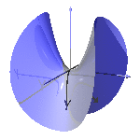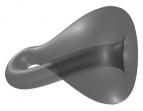Last weekend saw the gathering of virtual-world luminaries at the Metaverse Roadmap summit. ZDNet covers it, as does 3pointD.
Plenty to read there. I just want to highlight something 3pointD’s Mark Wallace writes, so I can riff off it:-)
[…] You might navigate a context-sensitive avatar from one world to another, bringing with you reputation data and other assets, though your virtual form and abilities would change to suit the 3D environment you were entering. And all virtual worlds would be accessed via a near-universal 3D browser (much like Web pages are today).
The ability to link the web to virtual worlds has been possible for a while. For example, here is a link to Google Earth for Austin Hall, Cambridge. 3pointD offers a link to Austin Hall [Second Life link] in Second Life.
On a lark, I tried linking from one virtual world to another, by creating a placemark for Austin Hall in Google Earth that links to Austin Hall in Second Life. It works! (At least on my Mac, using an external browser.)
“Linking” in web parlance becomes “teleporting” in avatar-speak, but whatever you call it, you’re mapping from one virtual world to another, binding them closer together, and that’s a good thing, metaverse-wise:-)
What about mapping every point in one world to a unique point in another world? That would make sense if the worlds describe the same place, as do Google Earth and NASA World Wind. It would make less sense, but might still be fun, if the places are different but the geometries are the same: For example, both virtual Mars and virtual Earth are described by an elliptic geometry, so their coordinates can do double duty.
Virtual worlds that do not try to mirror the Earth or other globes do not need to adopt an elliptic geometry. Indeed, Second Life exists in Euclidian (flat) space, as does World of Warcraft. Variations on the theme exist: Arthur C. Clarke’s book Rendezvous with Rama describes a cylindrical world. Halo takes place on a ring world.
 All this leaves plenty of room for metaversal innovation. Where is the virtual world described by hyperbolic geometry?
All this leaves plenty of room for metaversal innovation. Where is the virtual world described by hyperbolic geometry?  How about building a community on the surface of a Klein bottle, or a Möbius strip? I’d sign up for it, even if just to figure out what such mathematical spaces “feel” like. The future universal 3D browsers mooted by the Metaverse Roadmap would need to be able to render these other geometries, however.
How about building a community on the surface of a Klein bottle, or a Möbius strip? I’d sign up for it, even if just to figure out what such mathematical spaces “feel” like. The future universal 3D browsers mooted by the Metaverse Roadmap would need to be able to render these other geometries, however.
I think this is going to be the main attraction of virtual worlds over the real world: They don’t demand obeisance to the laws of physics, just the laws of mathematics, and even there you can decide the ground rules. I spend most of my time in Second Life and Google Earth flying around, for example, because I can.
It’s quite nonsensical to try and map on an n-dimensional non-euclidean object when it could only be conveyed in 2-dimensional euclidean space.